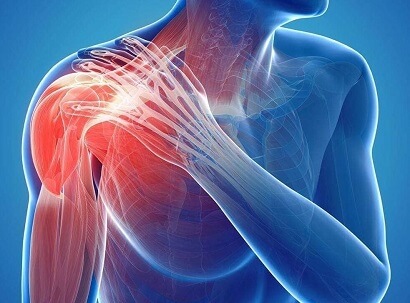Shoulder Pain
The shoulder complex is a dynamic region of the body. When we examine the shoulder we must consider the many different parts that are involved. The shoulder is comprised of the clavicle (collarbone), scapula (shoulder blade), and humerus (upper arm bone). This joint connects the arm to the thorax. The shoulder complex involves the glenohumeral (GH) joint, the scapulothoracic (ST) joint, the acromioclavicular (AC) joint, and the sternoclavicular (SC) joint. There are many moving parts in order to effectively use your arm. Aside from the bones and joints, the shoulder has many muscles involved in its function. The scapula has 17 muscle attachments alone!
Muscles and joints of the shoulder girdle can be common sources of pain (see Muscle & Joint Pain page). In addition to those, here are some shoulder conditions that physical therapy can help you with:
Subacromial Impingement syndrome – This is the most common disorder of the shoulder which involves impingement or “pinching” of the tissues in the shoulder. The pinching can occur on the bursa, the rotator cuff tendon, or biceps tendon. There is limited amount of space at the top of the shoulder (subacromial space) which makes it vulnerable for problems. Any mechanical faults due to muscle imbalances or joint stiffness can lead to impingement.
Rotator Cuff Tear – The rotator cuff is a group of 4 muscles in the shoulder that collectively work to provide stability and various movements of the arm. All 4 of the rotator cuff muscles originate from the scapula and attach to the humerus. Tears of the rotator cuff can occur from traumatic injuries such as motor vehicle accidents, sports injuries, or falls. More commonly, though, rotator cuff tears occur from repetitive wear and tear of the tendons from overuse and impingement as described above.
Biceps Tear – The biceps brachii is a two-headed muscle in the arm that attaches to the shoulder and the elbow. A tear of the proximal biceps tendon (at the shoulder) can be caused from acute or repetitive trauma and may or may not involve a SLAP tear as described below. A common finding in someone who tore their proximal biceps completely off the bone is a “Popeye” muscle. Part of the muscle rolls down the arm toward the elbow and makes a ball, bearing an appearance to the cartoon character’s arm muscles.
SLAP or Labral Tear – The glenohumeral joint is a ball-and-socket joint. The glenoid (socket) is surrounded by a fibrocartilaginous structure called the labrum which provides stability and adds depth to the joint. Injuries to labrum can be caused by acute trauma or repetitive shoulder motions similar to above. A SLAP tear or lesion is specific type of labral tear on the top of the labrum running from front to back. SLAP is an acronym for “superior labrum anterior to posterior.” This injury sometimes involves a biceps tendon problem as well due to its location in the shoulder.
Adhesive Capsulitis – Commonly referred to as frozen shoulder, this is a unique problem where the capsule (an envelope of ligamentous tissue that surrounds the joint) becomes significantly inflamed and stiff. The cause of frozen shoulder is unknown but it is more common in women and people between 40-60 years old. Individuals with recent trauma or surgery to the shoulder region, diabetics, and people with thyroid conditions are at a higher risk of developing this problem.

